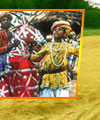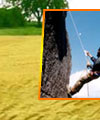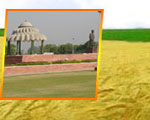| Encyclopedia of Tours and Travel to Haryana, featuring information on Fairs & Festivals, Wildlife, Excursion, Adventure & Weather of Haryana. |
 |
 |
 |
 |
 |
 |
 |
||
|
Excursion
Agroha The Agroha mound goes back to the 3rd century BC and is where Harappan coins were discovered apart from stone sculptures, terracotta seals, iron and copper implements, shells and a host of other things. Recent excavations have yielded five cultural periods ranging from circa fourth century to fourteenth century AD. The excavations have also revealed two ancient shrines namely a Buddhist stupa and a Hindu temple. Badkhal Lake Badkhal Lake, fringed by hills is a man-made embankment, which holds back the waters of the lake making it a perfect spot for water-sports. On one inlet in the surrounding hill there are rest huts, which are small, cozy and compact. On request, one can hire a private jetty for a pleasurable boat ride. The Badkhal Lake has also been provided with a compact and cool bath complex. Motels, restaurants, Minivet huts, camper huts, conference hall luxury launch for boating, filling station, children's park, a bank extension counter and adventure sport facilities of canoeing, kayaking, rock climbing and trekking available. Badkhal delights with its accommodation wings. View the serene lake. Luxury in the guestrooms is not over opulent, just welcoming. The rooms on the first floor have their own balconies. On the ground floor is a tiny garden, just for a chat or two, from where Badkhal Lake spreads out - far into the distance. Monsoon streams and rivulets have grooved the face of the august Aravalli hills. On one such inlet, rest the twin Minivet Huts that are cozy and compact, complete with two beds rooms, drawing room, kitchenette and a little garden. On request the private jetty gets a boat for a pleasurable evening. On similar spur, stand the Grey Falcon and Mayur restaurants. Each with its an ambience. Each with its unique cuisine. Badkhal has also been provided with a compact and cozy bath complex. The swimming pool has a decorated water feature, sauna chamber and massage units. A luxury yacht ride is not an impossible thing over the placid waters of the lake. On weekends and holidays, the crowds collect at Badkhal. The embankment bristles with sellers of snack food. The playground fills up. Badkhal also provides the essential services of a filling station and a bank extension counter. Birla Gita Mandir A large sized marble chariot is installed in the garden. The chariot drawn by four horses has Lord Krishna and Arjun seated on it with one couplet from each of the 18 chapters of Gita inscribed on all sides. A 'Gaj Ghanta' made of white marble has also been placed in the garden. There is a popular fable according to which a Titu bird had laid her eggs in the fields where the Mahabharat was fought and was worried about the safety of her children when she noticed the movements of the elephants. She prayed to God and a bell broke from the neck of an elephant and fell over the nest making it secure during the 18-day war of Mahabharata. Besides the idol of Lord Krishna, the main hall has portraits
of Guru Nanak, Guru Gobind, Sant Ravi Dass, Guru Teg Bahadur, Ved
Vyas and Tulsi Das along with their sayings. Hathni Kund
Jal Mahal The entrance to the palace is from the north through a gatehouse with rooms for guards, constructed over a bridge resting on sixteen arched spans. The palace consists of a square central chamber with four small chambers on the sides placed at its four corners. The corner chambers are double storeyed within the same height. Four staircases, two each in the north and south faces, give access to the upper storeys. The roof of the central chamber is crowned by an octagonal cupola surrounded by a hemispherical dome balanced by four smaller cupolas placed over the corner chambers. The Jal Mahal was constructed during the reign of Akbar in AD 1590 - 91. The tank was completed in AD 1592-93. Jyotisara A marble chariot depicting lord Krishna delivering the 'Shrimad Bhagwad Gita' to Arjun marks the site. In one of the secluded sections of this centre, an old Shiv temple can be seen. Hundreds of years ago, a tank measuring 1000x5000 feet was built here. Mansa Devi Temple The Legend This temple contains thirty-eight panels of wall paintings besides floral designs painted all over the ceiling and the arches leading into the temple. The drawings of the temple are not of high standard but a great variety of themes is illustrated. The other temple is said to have been constructed by Maharaja Karam Singh of erstwhile Patiala State to commemorate his success in the battle against the Gurkhas. Morni Hills Crowned by a pocket of pine trees, the hills look green and blue. The area is quiet, with hardly a bus moving up the hillside. The greens are yet undisturbed. The hills delight with their patches of green trees of pipal, jamun, dhak, the amaltas and the purple flowered jacaranda trees. The river Ghaggar cuts past the hills that are dotted with natural attractions. Two water bodies lie in these hills and are ideal for trek routes. Morni Hills have some villages, where farming is the main occupation. Exotic Flora And Fauna Rock Garden Sprawling over several acres of woods in the form of an open-air exhibition hall, theatre trove and a miniature maze all rolled into one vast fantasyland of art and landscape. It is without doubt, a tourist spot that is a must on the itinerary of every visitor to Chandigarh . The city's internationally acclaimed artist Nek Chand created this unique sculpture garden. Here, the visitor is led through a maze of paths, chambers and canyons, each presenting a glimpse of a fantasy world. The visual delights and the strange history of Rock Garden, has charmed millions of visitors since it was first opened to the public in 1976. The Classic Work Of Art The object to be seen there are the figures made of raw cement resembling humans and animals. These figures have been decorated with broken but colourful odds and ends of China clay. As one looks at them with deep intent, they seem to be staring at the visitors while engaged in various activities. There are a group of dancing damsels made from bicycle and motorcycle's waste materials, marching armies of warriors resting, flying or fledging birds, made from countless bits of broken glass. There are groups of music bands engaged in their activity of entertaining the visitors. Its creator also needs a mention. Suraj Kund The construction consists of a steeped stone embankment on a semi-circular plan to impound the rainwaters, from which were recently retrieved from the reservoir, or which are found re-used in later constructions. One can enjoy the placid waters of the lake, as there are facilities for boating. History Chronicled Suraj Kund Crafts Mela: The Life Of Suraj
Kund Tilyar Lake The tourist complex is splendid and large, and has varied tourist facilities. Tilyar Lake, a large lake attracts boating enthusiasts. There are guestrooms, restaurant, bar and a mini zoo for patrons. Tilyar attracts crowds of holidaymakers on weekends and holidays. Adventure sport facilities for kayaking and boating are available.
|
||||||||||
|
||||||||||
|
||||||||||
|---|---|---|---|---|---|---|---|---|---|---|